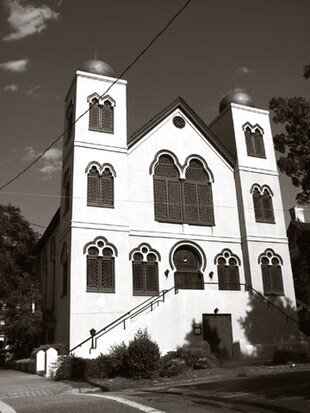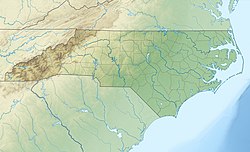Temple of Israel (Wilmington, North Carolina)
| Temple of Israel | |
|---|---|
 Temple of Israel façade | |
| Religion | |
| Affiliation | Reform Judaism |
| Ecclesiastical or organizational status | Synagogue |
| Leadership |
|
| Year consecrated | May 12, 1876 |
| Status | Active |
| Location | |
| Location | 1 South Fourth Street, Wilmington, North Carolina 28401 |
| Country | United States |
Location in North Carolina | |
| Geographic coordinates | 34°14′08″N 77°56′40″W / 34.23546°N 77.9444°W |
| Architecture | |
| Architect(s) | Samuel Sloan |
| Type | Synagogue |
| Style | |
| Date established | 1872 (as a congregation) |
| Completed | 1876 |
| Specifications | |
| Dome(s) | Two |
| Materials | Masonry; stucco |
| Website | |
| temple-of-israel | |
The Temple of Israel is a Reform Jewish synagogue located on the corner of Fourth and Market Streets in Wilmington, North Carolina, in the United States.[1] Built in 1876, the Temple of Israel is the oldest synagogue in North Carolina and one of the earliest Reform synagogues in the American South.[2][3] Temple of Israel is led by Rabbi Emily Losben-Ostrov.[4]
History
[edit]Sephardic Jews first arrived in North Carolina during the early 18th century.[3] By 1852, a Jewish Burial Society was formed in Wilmington with a Hebrew cemetery opening in 1855.[5] An Orthodox Jewish congregation was formed in 1867, but did not succeed. In 1872, a Reform congregation was started by German Jews and their synagogue, the Temple of Israel, was dedicated on May 12, 1876.[3][6]
Architecture
[edit]Designed by Samuel Sloan,[7] the synagogue is a combination of Greek Revival and Moorish Revival styles. The Moorish architecture is unique in the city of Wilmington, but was common during late 19th century for many American synagogues. The synagogue features horseshoe arches and twin towers topped with golden onion domes.[3][8] The building's exterior was restored in 1982, 2000 and 2013.[6] It is a contributing building in the Wilmington Historic District.
Notable members
[edit]- Arthur Bluethenthal[9] (1891–1918), Princeton All American football player and World War I pilot
References
[edit]- ^ Shimron, Yonat (September 8, 2009). "Temple anchors Wilmington's Jews". The News & Observer. newsobserver.com. Archived from the original on September 10, 2009. Retrieved September 8, 2009.
- ^ Prose, Francine (March 7, 1993). ""A Sojourn On Cape Fear"". New York Times. Retrieved May 17, 2008.
- ^ a b c d Chiat, Marilyn (1997). America's Religious Architecture: Sacred Places for Every Community. John Wiley & Sons. pp. 251. ISBN 0-471-14502-5.
- ^ Scherr, Andy (March 7, 1993). ""Passover is here"". WWAY. Archived from the original on May 26, 2011. Retrieved May 16, 2008.
- ^ Watson, Alan (2003). Wilmington, North Carolina, to 1861. McFarland. p. 154. ISBN 0-7864-1427-8.
- ^ a b ""Overview"". Temple of Israel. Archived from the original on April 15, 2008. Retrieved May 17, 2008.
- ^ Serrano, Nicholas (2012). Esperdy, Gabrielle; Kingsley, Karen (eds.). "Temple of Israel [Wilmington, North Carolina]". SAH Archipedia. Charlottesville: Society of Architectural Historians. Retrieved December 26, 2023.
- ^ Hutteman, Anne (2000). Wilmington, North Carolina. Arcadia Publishing. p. 75. ISBN 0-7385-0639-7.
- ^ "Bluethenthal, Arthur "Bluey"". Jewsinsports.org. Archived from the original on December 5, 2010. Retrieved December 22, 2010.
External links
[edit]- 1872 establishments in North Carolina
- Buildings and structures in Wilmington, North Carolina
- German-American culture in North Carolina
- German-Jewish culture in the United States
- Gothic Revival architecture in North Carolina
- Gothic Revival synagogues
- Greek Revival architecture in North Carolina
- Greek Revival synagogues
- Reform synagogues in North Carolina
- Synagogues completed in 1876
- Jewish organizations established in 1872
- Moorish Revival architecture in North Carolina
- Moorish Revival synagogues
- 19th-century synagogues in the United States
- Samuel Sloan buildings

